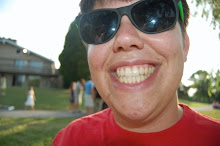Shvat 17, 5767
Around this time every year, Congregation Beth Israel (my temple) brings in our Scholar-in-Residence for our annual Scholar-in-Residence weekend. This year we brought in a Reconstructionist Rabbi named Sid Schwarz. If anybody has been giving serious thought to the problems that plague every Jewish congregation in America, regardless of denomination, Sid is that person.
--
SYNAGOGUE CENTER into SYNAGOGUE COMMUNITY
On Friday night, he spoke after tfilah in lieu of a sermon. Sid believes that the American synagogue has been through three phases and is on the cusp of a fourth. Congregations that do not make the leap to the fourth will suffer tremendously and eventually disappear. When our ancestors arrived in America with little financial means, they all lived in the same neighborhoods. In those neighborhoods people met in storefronts and apartment living rooms to pray together and celebrate life cycle events together. This was the first stage. Then, more affluent, though pre-WWII, American Jews had real synagogues. They lived a little more spread out form each other and their synagogues had modest budgets. They had a Rabbi, maybe a Cantor and perhaps an office worker. This was stage two. After WWII, having truly made it here, American Jewry departed each other's company for the suburbs. Their synagogues stayed in the cities and they commuted to religious school and services. This is the model currently in use, which Sid calls the Synagogue Center. People treat it like everything else in their lives; a business transaction. They want goods and services and the synagogue provides those things. If it does not provide them or provides them at what the consumer thinks is an unfair cost, they take their business elsewhere, or worse, they end their affiliation with a synagogue altogether. Sid envisions the fourth stage vividly. In his book, he profiles a Reconstructionist, Reform, Conservative, and an Orthodox synagogue in American which he says have entered the fourth phase. He calls it, the Synagogue Community. The Synagogue Center is shaped like a pyramid. Envision the food pyramid. In place of the tiny junk food layer at the top, place the leadership and people engaged in activities around the synagogue. They make up 5-10% of the membership. Everything below that is a complaining, baldy-informed, hardly-involved mass of dues-paying members. The Synagogue Community is round. In the center is nucleus of leadership, the board, employees, etc. Orbiting around the nucleus is many cells of activity. One is the youth group. One is the group that goes to the soup kitchen every Sunday evening. One is the group that runs Tot Shabbat. One is the sisterhood. Et cetera. Each is linked to the other and all are linked to the center. People do not come anymore because they want a product. Now they come because of the community.
--
SHABBAT SHACHARIT on ACID
Sid led tfilah with out Cantor, David Reinwald, on Shabbat morning. He called it "Davening Outside of the Box." The name turned me off a bit. I tend to want to get in the box, shut the lid, and not listen to what anybody has to say about the matter.
We set up the chapel in a semi-circular fashion, which I liked much more than our usual configuration of straight east-facing rows. I should note that by then end, it was basically standing room only. I have never seen our small chapel so full of people.
For Birkot Hashachar, Sid recited, in English, the end of each line. For example, in the case of the first one in Big Blue, Sid said “who implants mind and instinct within every living being.” Then someone would stand and give an example of a time or occurrence in their life which reminded them of the particular brachah. They would then offer the brachah and the process would start over with Sid reciting the ending of the next one in English. It was not my favorite thing ever, but I did open myself to the experience enough to share during one of the brachot. I should note that after this, none of the actual liturgy was in English.
The Amidah almost caused me to have a fit. My routine for the Amidah is that during the Haskivenu, which directly precedes the Amidah, I get out Ha'avodah Shebalev and move to the back. I then do the opening section (Avot V’imahot, Gvurot, and Kedusha) with congregation out loud, then I remain standing and do the Amidah as they sit and do something Amidah-like. Sid informed us we were doing something creative for the Amidah. I did not even stay for the rest of the explanation. I departed immediately and did the Amidah on my own in another room. When I came back the chapel was buzzing with conversation. As it turned out, people were discussing Jewish role models or something as a means for understanding Avot V'imahot. Then, when they were done, they were davening the Amidah on their own, must of them, apparently at Sid's urging, with their talit, or in many cases, other people's talitot, on their heads. Whatever.
Also in this service were skits. We broke into groups and created skits on different parts of Ashrei.
Skits. Really?
Kadish Yatom was done with only mourners standing. At least one person I talked to had a physical reaction to this, so turned off by the practice was she. In our congregation, everyone rises and everyone says Kadish with the mourners.
Overall, the service was success. Everyone present smiled at some point.
2.04.2007
Subscribe to:
Post Comments (Atom)

2 comments:
It is an amusing phrase
What interesting question
Post a Comment